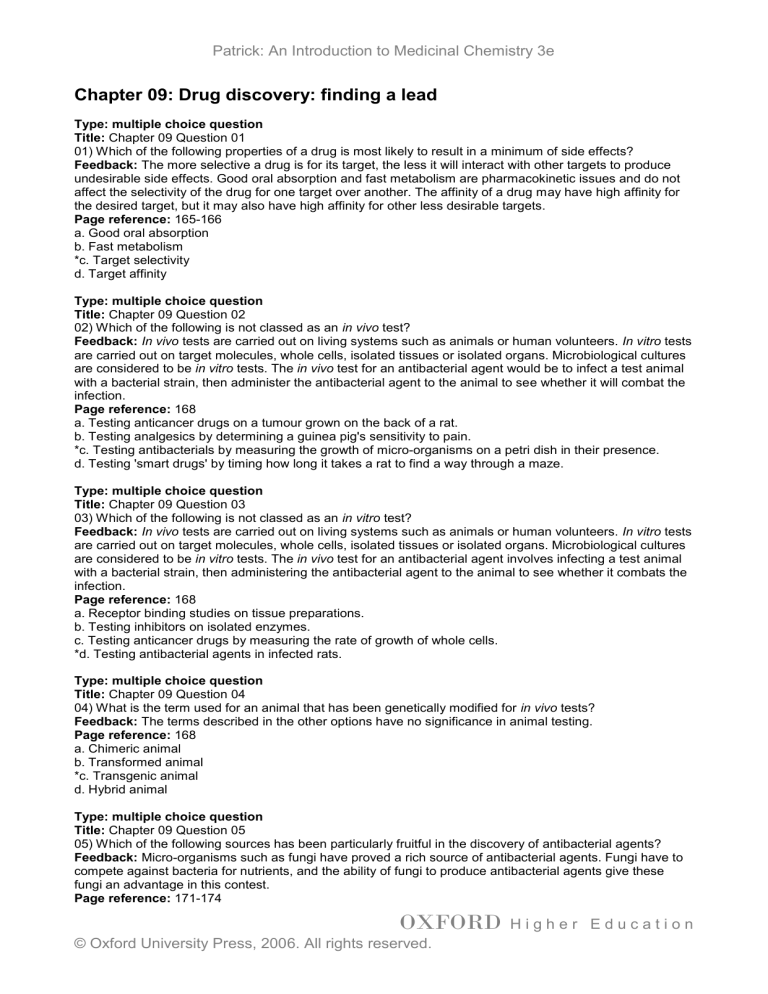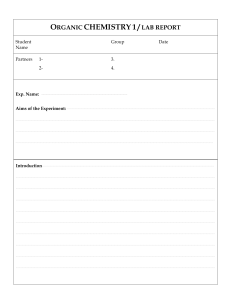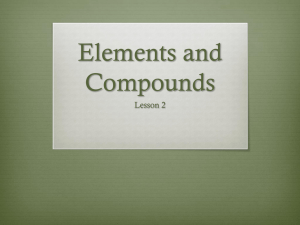
Patrick: An Introduction to Medicinal Chemistry 3e Chapter 09: Drug discovery: finding a lead Type: multiple choice question Title: Chapter 09 Question 01 01) Which of the following properties of a drug is most likely to result in a minimum of side effects? Feedback: The more selective a drug is for its target, the less it will interact with other targets to produce undesirable side effects. Good oral absorption and fast metabolism are pharmacokinetic issues and do not affect the selectivity of the drug for one target over another. The affinity of a drug may have high affinity for the desired target, but it may also have high affinity for other less desirable targets. Page reference: 165-166 a. Good oral absorption b. Fast metabolism *c. Target selectivity d. Target affinity Type: multiple choice question Title: Chapter 09 Question 02 02) Which of the following is not classed as an in vivo test? Feedback: In vivo tests are carried out on living systems such as animals or human volunteers. In vitro tests are carried out on target molecules, whole cells, isolated tissues or isolated organs. Microbiological cultures are considered to be in vitro tests. The in vivo test for an antibacterial agent would be to infect a test animal with a bacterial strain, then administer the antibacterial agent to the animal to see whether it will combat the infection. Page reference: 168 a. Testing anticancer drugs on a tumour grown on the back of a rat. b. Testing analgesics by determining a guinea pig's sensitivity to pain. *c. Testing antibacterials by measuring the growth of micro-organisms on a petri dish in their presence. d. Testing 'smart drugs' by timing how long it takes a rat to find a way through a maze. Type: multiple choice question Title: Chapter 09 Question 03 03) Which of the following is not classed as an in vitro test? Feedback: In vivo tests are carried out on living systems such as animals or human volunteers. In vitro tests are carried out on target molecules, whole cells, isolated tissues or isolated organs. Microbiological cultures are considered to be in vitro tests. The in vivo test for an antibacterial agent involves infecting a test animal with a bacterial strain, then administering the antibacterial agent to the animal to see whether it combats the infection. Page reference: 168 a. Receptor binding studies on tissue preparations. b. Testing inhibitors on isolated enzymes. c. Testing anticancer drugs by measuring the rate of growth of whole cells. *d. Testing antibacterial agents in infected rats. Type: multiple choice question Title: Chapter 09 Question 04 04) What is the term used for an animal that has been genetically modified for in vivo tests? Feedback: The terms described in the other options have no significance in animal testing. Page reference: 168 a. Chimeric animal b. Transformed animal *c. Transgenic animal d. Hybrid animal Type: multiple choice question Title: Chapter 09 Question 05 05) Which of the following sources has been particularly fruitful in the discovery of antibacterial agents? Feedback: Micro-organisms such as fungi have proved a rich source of antibacterial agents. Fungi have to compete against bacteria for nutrients, and the ability of fungi to produce antibacterial agents give these fungi an advantage in this contest. Page reference: 171-174 OXFORD © Oxford University Press, 2006. All rights reserved. Higher Education Patrick: An Introduction to Medicinal Chemistry 3e a. Plant extracts b. Venoms and toxins *c. Micro-organisms d. Animals Type: multiple choice question Title: Chapter 09 Question 06 06) From which source did the lead compound for the antihypertensive agent captopril come? Feedback: Teprotide is a peptide which was isolated from the venom of the Brazilian viper and was the lead compound for the development of the antihypertensive agent captopril. Page reference: 173 a. Marine sources *b. Venoms and toxins c. Combinatorial chemistry d. Animals Type: multiple choice question Title: Chapter 09 Question 07 07) What term is used for the chemical which is chiefly responsible for the biological activity of a natural extract? Feedback: The other terms are not used in medicinal chemistry. Page reference: 171 a. Active drug b. Prime drug *c. Active principle d. Prime principle Type: matching question Title: Chapter 09 - Question 08 08) Which of the following is obtained from: Feedback: Tubocurarine is the active principle of the arrow poison ourari. Cocaine is extracted from leaves of the coca bush. Morphine is extracted from opium. Quinine is extracted from cinchona bark. Page reference: 171-172, 618, 575 a. Opium? = Morphine b. Ourari? = Tubocurarine c. The cinchona bark? = Quinine d. The leaves of the coca bush? = Cocaine Type: matching question Title: Chapter 09 - Question 09 09) Which of the following is obtained from: Feedback: Salicin is extracted from the willow tree. Reserpine is extracted from the snakeroot plant. Emetine is extracted from ipecacuanha root. Digitalis is extracted from the foxglove. Page reference: 171-172 a. The willow tree? = Salicin b. The foxglove? = Digitalis c. The ipecacuanha root? = Emetine d. The snakeroot plant? = Reserpine Type: multiple choice question Title: Chapter 09 Question 10 10) Natural products are often used as lead compounds in the design and synthesis of novel drugs. Which of the following general characteristics of a natural product is most likely to be a disadvantage in synthesising analogues? Feedback: Natural products are often complex in structure which makes their synthesis difficult. As a result, the synthesis of analogues can also be difficult. Page reference: 171 a. Novelty of structure *b. Complexity of structure c. Level of activity OXFORD © Oxford University Press, 2006. All rights reserved. Higher Education Patrick: An Introduction to Medicinal Chemistry 3e d. Availability Type: multiple choice question Title: Chapter 09 - Question 11 11) What is meant when a lead compound is found by serendipity? Feedback: There is no pharmaceutical company called serendipity, no serendipity region of the African Veldt and no experimental procedure known as serendipity. Page reference: 178-180 a. It was found by a pharmaceutical company by the name of serendipity. b. It was found in the serendipity region of the African Veldt. *c. It was discovered by chance. d. It was found by an experimental procedure known as serendipity. Type: multiple choice question Title: Chapter 09 - Question 12 12) Which of the following analytical techniques provides the greatest structural information on a lead compound? Feedback: Nuclear magnetic resonance spectroscopy provides the most information about structure since it indicates the type of atoms that are present as well as the way in which these atoms are linked together. Ultra-violet spectroscopy is limited to providing information about the conjugation of a molecule. Infra-red spectroscopy is limited to providing information about the sort of functional groups that are present. Elemental analysis only provides the relative percentage of elements that are present. Page reference: 182 *a. Nuclear magnetic resonance spectroscopy b. Ultra-violet spectroscopy c. Infra-red spectroscopy d. Elemental analysis Type: multiple choice question Title: Chapter 09 - Question 13 13) Which of the following is not an endogenous compound? Feedback: A lead compound is a compound that acts as the starting point for drug design and development. It may have disadvantages such as low activity or the presence of side effects, but it acts as a starting point for the development of a better agent. An active principle is the active constituent of a natural extract. A pharmacophore is the essential groups required for some kind of pharmacological activity. An orphan drug is a compound that is effective against a rare disease. Page reference: 178 a. Active principle b. Pharmacophore *c. Lead compound d. Orphan drug Type: multiple choice question Title: Chapter 09 - Question 14 14) Which of the following is not an endogenous compound? Feedback: Endogenous compounds are any compounds occurring naturally in the body. Desipramine is a synthetic drug and is not an endogenous compound. Page reference: 164 a. Dopamine b. Lactate dehydrogenase c. Moradrenaline *d. Desipramine Type: multiple choice question Title: Chapter 09 - Question 15 15) What term refers to a compound that acts as the starting point for drug design and development? Feedback: A lead compound is a compound that acts as the starting point for drug design and development. It may have disadvantages such as low activity or the presence of side effects, but it acts as a starting point for the development of a better agent. An active principle is the active constituent of a natural OXFORD © Oxford University Press, 2006. All rights reserved. Higher Education Patrick: An Introduction to Medicinal Chemistry 3e extract. A pharmacophore is the essential group required for some kind of pharmacological activity. An orphan drug is a compound that is effective against a rare disease. Page reference: 178 a. Active principle b. Pharmacophore *c. Lead compound d. Orphan drug Type: multiple choice question Title: Chapter 09 - Question 16 16) Which of the following reflects the order in which various stages of the drug discovery and development take place? Feedback: It is necessary to decide what the molecular target is before a bioassay can be established. The bioassay is required in order to detect a structure that is pharmacologically active and which can act as the lead compound. Structure-activity relationships can then be carried out on the lead compound. Page reference: 163-183 *a. Determining a target, establishing a bioassay, finding a lead compound, structure activity relationships b. Establishing a bioassay, determining a target, finding a lead compound, structure activity relationships c. Determining a target, establishing a bioassay, structure activity relationships, finding a lead compound, d. Determining a target, finding a lead compound, structure activity relationships, establishing a bioassay, Type: multiple choice question Title: Chapter 09 - Question 17 17) Which of the following statements about high throughput screening is false? Feedback: It is an in vitro process rather than in vivo process. Usually genetically modified cells are used. Page reference: 169 a. It is an automated process *b. It is an in vivo process c. It is carried out on a small scale d. It can be carried out on large numbers of compounds in a short time Type: multiple choice question Title: Chapter 09 - Question 18 18) Which of the following statements is false with respect to nmr screening to detect drug-target interactions? Feedback: The method can detect weak bonding which is one of its advantages over more traditional methods of detecting drug-target interactions. Page reference: 169-170 a. The procedure relies on small molecules (drugs) having longer relaxation times than large molecules (targets). b. The procedure can be used on mixtures of compounds. *c. The method cannot detect weak binding d. The method can identify small molecules binding to different regions of the same binding site. Type: multiple choice question Title: Chapter 09 - Question 19 19) What is the name of the detection system patented by Pharmacia Biosensor that can detect a ligand binding to a target using the phenomenon known as surface plasmon resonance? Feedback: BIAcore is the name of the detection system. The other options are ficticious. Page reference: 170 a. BIOsystems b. Bioplasma *c. BIAcore d. BIAdetection Type: multiple choice question Title: Chapter 09 - Question 20 20) A scintillation proximate assay makes use of a specific radioisotope which interacts with a scintillant to emit light. Which isotope is involved? OXFORD © Oxford University Press, 2006. All rights reserved. Higher Education Patrick: An Introduction to Medicinal Chemistry 3e Feedback: Scintillation proximate assay involves the immobilisation of a target molecule on beads coated with a scintillant. A ligand labelled with 125I binds to the target and the radioisotope interacts with the scintillant to emit light. 3H and 14C are both radioisotopes used in drug metabolism studies. 13C is a stable isotope of carbon which can be detected using nuclear magnetic resonance spectroscopy. Page reference: 171 *a. 125I b. 3H c. 13C d. 14C Type: multiple choice question Title: Chapter 09- Question 21 21) The following diagram illustrates the detection system known as surface plasmon resonance. What is represented by A? Feedback: Symbol A represents a receptor which is covalently linked to the dextran matrix and which will bind ligands present in the buffer flow. B is monochromatic plane-polarised light. C is the flow of buffer solution. D is the evanescent wave which interacts with free oscillating electrons called plasmons in the metal film when the angle of incidence (α) is right. Page reference: 170 a. The evanescent wave b. Monochromatic plane-polarised light *c. The receptor d. The flow of buffer solution Type: multiple choice question Title: Chapter 09- Question 22 22) There are several sources and methods of discovering new compounds. Which of the following is an in silico method? Feedback: In silico methods involve the use of computer software programmes. Database mining involves the computerised search of known compounds for particular pharmacophores. Screening plant extracts involves a search for active principles that can act as lead compounds. Some natural products are quite bizarre in structure! Combinatorial chemistry involves the synthesis of a large number of compounds using a standard synthetic route and so the types of structures that will be synthesised are predictable and belong to a similar family of compounds. Me too drugs are analogues of an established drug. Page reference: 180 a. Combinatorial chemistry *b. Database mining c. Screening plant extracts d. Me too drugs OXFORD © Oxford University Press, 2006. All rights reserved. Higher Education Patrick: An Introduction to Medicinal Chemistry 3e Type: multiple choice question Title: Chapter 09 - Question 23 23) From which source did the lead compound for the antiulcer agent cimetidine come from? Feedback: The lead compound for cimetidine was histamine which is an endogenous compound i.e. one of the body's own chemicals. Page reference: 177 a. Marine sources b. Venoms and toxins c. Combinatorial chemistry *d. An endogenous compound Type: multiple choice question Title: Chapter 09 - Question 24 24) Which of the following drugs is isolated from a natural source? Feedback: Morphine is isolated from the poppy plant. Aspirin and diamorphine are semi synthetic drugs prepared from compounds isolated from a natural source. Isoniazid is synthesised in the laboratory. Page reference: 164 a. Aspirin *b. Morphine c. Isoniazid d. Diamorphine (Heroin) Type: multiple choice question Title: Chapter 09 - Question 25 25) What is the term used for drugs such as cilazapril, lisinopril and enalapril, all of which were developed as antihypertensives following the discovery of captopril? Feedback: Orphan drugs are those drugs that are effective against particularly rare ailments. An active principle is a natural product that is chiefly responsible for the pharmacological activity of a natural extract. The drugs described can be described as analogues of captopril, but the term used to describe active analogues that have reached the market is 'me too' drugs. Page reference: 175 a. Orphan drugs *b. Me too drugs c. Active principles d. Analogues Type: multiple choice question Title: Chapter 09- Question 26 26) Natural products are often used as lead compounds in the design and synthesis of novel drugs. Which of the following general characteristics of a natural product is most likely to be a disadvantage? Feedback: It can often be tedious and expensive to extract an active compound from its natural source. Natural products are also often complex in structure which makes their synthesis difficult. Page reference: 171 a. Novelty of structure OXFORD © Oxford University Press, 2006. All rights reserved. Higher Education Patrick: An Introduction to Medicinal Chemistry 3e *b. Its availability c. Level of activity d. Availability Type: multiple choice question Title: Chapter 09- Question 27 27) Which of the following terms is used to indicate to a lead compound that it is one of the body's own chemicals? Feedback: Endogenous compounds are any compounds occurring naturally in the body. These are also biochemicals but this is not the term that is used in medicinal chemistry. A hormone and a neurotransmitter are examples of endogenous compounds, but not all endogenous compounds are hormones or neurotransmitters. Page reference: 177 a. A neurotransmitter b. A biochemical c. A hormone *d. An endogenous compound Type: multiple choice question Title: Chapter 09- Question 28 28) Which of the following is not an endogenous compound? Feedback: Endogenous compounds are any compounds occurring naturally in the body. Fluoxetine is a synthetic drug and is not an endogenous compound. Page reference: 163 a. Adrenaline *b. Fluoxetine c. Serotonin d. Testosterone Type: multiple choice question Title: Chapter 09- Question 29 29) The following diagram shows a process by which a drug can be designed with the aid of nuclear magnetic resonance spectroscopy. What is the process called? Feedback: Epitopes are small molecules capable of binding to small regions of the overall binding site. By optimising these and linking them, it should be possible to design an active compound. The process involves NMR screening, but NMR screening could also involve general screening of compounds with no design strategy involved. De novo drug design and structure-based drug design are design processes involving the use of molecular modelling software. Page reference: 180 a. NMR screening *b. Epitope screening c. De novo drug design d. Structure-based drug design Type: multiple choice question OXFORD © Oxford University Press, 2006. All rights reserved. Higher Education Patrick: An Introduction to Medicinal Chemistry 3e Title: Chapter 09- Question 30 30) Which of the following statements is not true of herbal medicines? Feedback: It is quite likely that herbal medicines may have a number of active principles responsible for one or more pharmacological effects. Page reference: 183 *a. Herbal medicines contain a single active principle that is responsible for its action. b. Herbal medicines can have side effects. c. It is more difficult to receive an overdose of an active drug if it is present in a herbal medicine rather than as a pure medicine. d. Certain compounds in herbal medicines may enhance the activity of the active principle. OXFORD © Oxford University Press, 2006. All rights reserved. Higher Education





